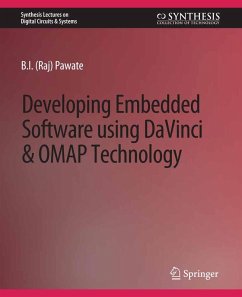This book discusses how to develop embedded products using DaVinci & OMAP Technology from Texas Instruments Incorporated. It presents a single software platform for diverse hardware platforms. DaVinci & OMAP Technology refers to the family of processors, development tools, software products, and support. While DaVinci Technology is driven by the needs of consumer video products such as IP network cameras, networked projectors, digital signage and portable media players, OMAP Technology is driven by the needs of wireless products such as smart phones. Texas Instruments offers a wide variety of processing devices to meet our users' price and performance needs. These vary from single digital signal processing devices to complex, system-on-chip (SoC) devices with multiple processors and peripherals. As a software developer you question: Do I need to become an expert in signal processing and learn the details of these complex devices before I can use them in my application? As a senior executive you wonder: How can I reduce my engineering development cost? How can I move from one processor to another from Texas Instruments without incurring a significant development cost? This book addresses these questions with sample code and gives an insight into the software architecture and associated component software products that make up this software platform. As an example, we show how we develop an IP network camera. Using this software platform, you can choose to focus on the application and quickly create a product without having to learn the details of the underlying hardware or signal processing algorithms. Alternatively, you can choose to differentiate at both the application as well as the signal processing layer by developing and adding your algorithms using the xDAIS for Digital Media, xDM, guidelines for component software. Finally, you may use one code base across different hardware platforms. Table of Contents: Software Platform / More about xDM, VISA, & CE / Building a Product Based on DaVinci Technology / Reducing Development Cost / eXpressDSP Digital Media (xDM) / Sample Application Using xDM / Embedded Peripheral Software Interface (EPSI) / Sample Application Using EPSI / Sample Application Using EPSI and xDM / IP Network Camera on DM355 Using TI Software / Adding your secret sauce to the Signal Processing Layer (SPL) / Further Reading
Dieser Download kann aus rechtlichen Gründen nur mit Rechnungsadresse in A, B, BG, CY, CZ, D, DK, EW, E, FIN, F, GR, HR, H, IRL, I, LT, L, LR, M, NL, PL, P, R, S, SLO, SK ausgeliefert werden.


